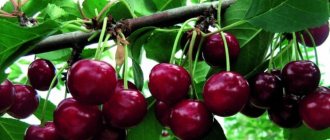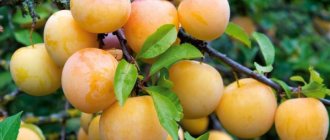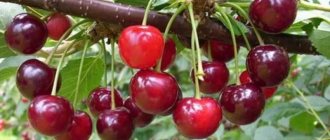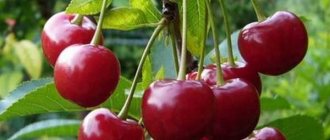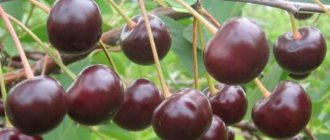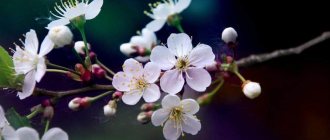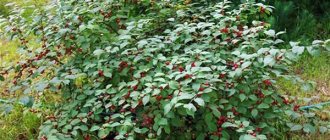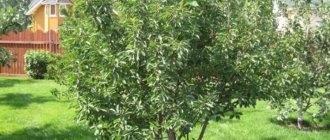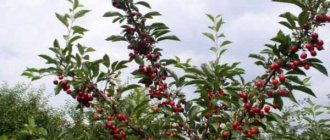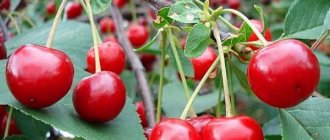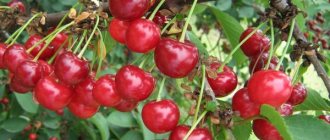Beautiful spreading cherry trees are not uncommon for gardens in the southern regions and central Russia. They produce a bountiful harvest of sweet berries with a slight sourness. Those involved in breeding know that the main indicators for plants are frost resistance and good immunity. Cherry Kharitonovskaya is an excellent example of fruitful hybrids. The large size of the berries, excellent taste and ease of cultivation and care make it popular among gardeners. Dessert cherries are perfectly stored, can be used for winter preparations and eaten fresh.
History of the variety
Kharitonovskaya traces its history back to 1992. She was taken out at the Institute. Michurina. Already in 1998, the hybrid was accepted by the State Register. It got its name from the name of one of its creators. One plant combines the features of several species: Almaz and Zhukovskaya. They themselves are also hybrids. Almaz is a descendant of the hybrid Padocerus-M, and Zhukovskaya is a duk, which means cherry-cherry.
The story of the first hybrid is amazing. It was created from Ideal cherry and Maak bird cherry, growing in the Primorsky Territory. The combination of qualities of different species in one plant made it resistant to frost and various diseases.
Michurin was the first to cross cherry with bird cherry. Cerapadus and padocerus are now very different from those first ones. Their berries have become more tasty, larger and juicier. Despite the mother tree - bird cherry, they all belong to the category of cherries.
Growing technique, planting and subsequent care
It is better to plan to plant seedlings in early autumn, before the onset of frost. First, decide on the landing site. It is worth choosing areas on hills that are illuminated and protected from northern winds. A good solution is to place the tree on the south side of the garden, where it will receive maximum sunlight.
Important! When planting, it is important to maintain a distance between trees - 3 m, and between rows - 3-4 m.
Landing rules
Optimal soil types
Kharitonovka is a cherry that prefers sandy loam soils with neutral acidity. Groundwater should be located at a depth of 1.5 m.
Description of the plant
Description of the Kharitonovskaya cherry variety has several features. It is medium-sized and can reach a height of 2.5-3 meters. The crown grows in width. When planting, you must take this feature into account and leave more space for the plant. There should be at least 3 meters between trees, and 4 meters between rows.
In appearance, Kharitonovskaya resembles other varieties of the species:
- The leaves are rich green, with a pointed tip and jagged edge. They are quite large, smooth and glossy, without lint.
- The buds are dense and covered with a leathery brown skin. They are pressed very tightly to the branches.
- The hybrid blooms in large white clusters. In spring, the trees resemble brides in wedding attire.
- The stalk is not very long; it comes off the branch well, but poorly from the berry.
- The fruits are born very large, up to 5 grams. They have a dark red tint with slightly noticeable light spots under the skin. The fruits have a sweet and sour taste.
- The bone is also quite large. It releases well from the pulp, which makes the cleaning process easier.
The fruits of Kharitonovskaya are rated very highly by tasters. They score 4.75 on the taste scale.
Reviews from gardeners about the Kharitonovskaya cherry variety
We planted Kharitonovskaya cherry, self-fertile, on our plot. Having listened to the recommendations of the owner of the plantation, we bought another variety for better pollination. We bought additional Zhukovsky cherry variety, and Vladimirovskaya was already on the site. Last year we already had our first harvest of delicious, aromatic, sweet and sour cherry fruits from Kharitonovskaya.
Lenochok
https://www.divosad.ru/forum/9–271–1
Kharitonovskaya is beyond praise - tasty, large, although the bone is a bit too big, and does not suffer from moniliosis or coccomycosis, unlike others, with the same care. I treat them all with fungicides twice during the season. Today I’m going to buy a few more Kharitonovskaya seedlings from the nursery.
galley
https://dacha.wcb.ru/index.php?showtopic=12818&st=60
Today we picked the fruits of the Kharitonovskaya cherry variety. In our area this is one of the largest-fruited varieties. This is the largest-fruited variety in my garden this year. The average fruit weight is 5.7 g. The juice is colored, semi-dry, the stone is large, weighing 0.5 g. The bone is well separated from the pulp. The taste is very good, but the variety is inferior in taste to the Assol and Lebedyanskaya varieties. Plants of the Kharitonovskaya variety have increased resistance to moniliosis and coccomycosis.
Victor Bratkin
https://forum.prihoz.ru/viewtopic.php?t=1148&start=1650
Nutrient content
Cherries are very healthy. They contain a large amount of vitamins and microelements. They perfectly boost immunity, serve to prevent colds, and normalize the functioning of the circulatory system.
The berries contain:
- 15 percent dry matter;
- 7 percent sugars;
- 2% acids;
- 11 milligrams of ascorbic acid per 100 grams of product.
The fruits of Kharitonovskaya are quite sweet when compared to other species. Another plus is the size of the berries. They are very large when fully ripe.
Suitable substrate
Cherry Kharitonovskaya (photo below) prefers loose sandy loam well-drained soil with a neutral reaction. This substrate warms up well, is moisture-intensive and breathable. The soil must first be enriched with nutrients. During the digging process, it is necessary to add organic, potassium and phosphorus fertilizers. If the soil is acidic, soddy-podzolic, then a liming procedure will be necessary. Otherwise, the seedling will not be able to take root.
Before planting a seedling, you should inspect its roots for damage. All unhealthy parts must be removed. It is recommended to immerse dried roots in water for three or four hours.
Pros and cons of the variety
Each fruit plant has its own advantages and disadvantages. Cherry is no exception. Despite the fact that its fruits have healing properties, not every variety takes root in the garden plot and in the hearts of gardeners.
Kharitonovskaya has everything necessary to be at the forefront:
- it produces a consistently large harvest every year;
- is resistant to most fungal diseases;
- the fruits have outstanding taste;
- berries can be transported over long distances;
- the plant is small in size;
- the berries adhere firmly to the stalk and do not begin to crumble after ripening;
- the plant is not afraid of drought;
- The fruits can be used fresh and after heat treatment.
The only drawback of the variety is its poor frost resistance. In harsh climates, the plant's buds freeze, which leads to its death or poor fruiting.
Kharitonovskaya cherry thrives in the southern and central regions of the country.
Diseases and pests
At the end of the vegetative phase and after harvesting, carry out preventive treatment of the plant against coccomycosis and hole spot . It is better to spray Bordeaux mixture or Azofos fungicide. The main thing is to have time to treat the tree before flowering.
To protect the tree from fungal diseases, promptly remove and burn fallen leaves.
Tie the tree trunk with spruce branches or a special mesh to create a protective barrier against small rodents and hares in winter..
Important! Inspect your cherry tree regularly to ensure you don't miss any negative changes in the plant's condition.
Characteristics
Fruit plants are valued for their resistance to drought and frost, high immunity and productivity. When all the required qualities are combined in one hybrid, this is an excellent option for growing.
- In hot summers it can withstand high temperatures, but this does not mean that the tree must be deprived of moisture on purpose. It is recommended to water cherries 2 times a month.
- The frost resistance of the hybrid is average. It’s better not to take risks and not set up a garden only with Kharitonovskaya in the north. In the southern regions it bears fruit better and does not suffer from winter temperature changes.
- The plant blooms at the end of May. By the end of July you can begin to collect the first fruits. There are a lot of flowers on the tree, but only 5-20 percent of them turn into berries.
- To increase productivity, pollinators must be planted near Kharitonovskaya. For these purposes, varieties such as Zhukovskaya and Vladimirskaya are suitable.
- The first harvest can be obtained 5 years from the date of planting. Each mature tree, with good care, can produce up to 20 kilograms of tasty large berries.
- This variety is not afraid of coccomycosis. Pests can threaten it, so prevention is inevitable.
Pollinators play an important role in crop production. They allow 80-85 percent of the flowers to grow in the ovary. In this case, the distance between trees must be at least 4 meters.
This is what the Kharitonovskaya cherry looks like during the flowering period
Harvest and storage
In terms of the speed of fruit ripening, Kharitonovskaya cherry is mid-season . The tree begins to bear fruit 4–5 years after planting. The berries ripen between the 10th and 20th of July.
It is advisable to start picking berries in dry weather: carefully pick them with your hands in several passes. To extend the shelf life, remove the fruits along with the stalks, and you can use scissors. Pick berries from the top and south side of the tree first.
If the cherry is immediately processed, then you can pick it without the stem, it’s much faster.
In the kitchen, the harvested crop will spoil after 2 days. The berries are stored in the refrigerator for about a week. Freezing and preparing various types of preserves from cherries (jam, compote) help to significantly extend the shelf life.
To get a decent harvest of tasty and healthy berries on your plot, follow the above recommendations. Having grown an adult cherry tree of the Kharitonovsky variety, you will appreciate all its qualities.
Scope and methods of processing berries
The dessert variety is intended for fresh consumption, but large harvests must be sold somewhere. Kharitonovskaya can be sent for sale. Cherry has average indicators of transportability and storage. The berries have a slight cherry aroma, which may confuse buyers.
Various winter preparations are often made from the fruits: jams, juices, compotes, wines. They are used fresh and frozen to decorate desserts. Cherries can be stored ground with sugar or whole in the freezer.
The light aroma and aftertaste of bird cherry gives wines made from Kharitonovskaya a piquant taste.
Tree care in autumn
In the fall, the soil on the site and under the tree must be dug up, fertilizer applied and the plant prepared for wintering. Preparation consists of forming comprehensive protection of the root system and trunk from rodents and frost.
In autumn, phosphorus and potassium fertilizers are applied to the soil. Suitable organic substances include sawdust, compost, bird droppings, and manure. After fertilizing the substrate, it must be dug to a depth of 20-25 centimeters.
To protect from frost, the tree should be covered with snow and mulch (sawdust, straw) should be poured on top.
A mixture of clay, mullein and iron sulfate will help protect cherries from rodents.
Landing
Every plant needs favorable conditions for development. When planning to plant a cherry orchard, homeowners must choose a good location and take care of quality seedlings. It is important to decide on the variety, since not every plant can withstand harsh climatic conditions.
Choosing a suitable location
Cherry prefers warm and sunny areas. It can be planted on the south or west side, from natural or artificial shelter. The tree does not like winds and drafts, which can damage the flowers. Groundwater should be located no higher than 2 meters. Their abundance leads to root rot and plant death.
For comfortable growth of cherries, light loams are suitable. They can be enriched with humus, mixed with sand, diluted with fertilizers or lime. Kharitonovskaya cherry also grows in black soil. Timely fertilization will allow it to develop and produce a large harvest regardless of weather conditions.
Planting times vary by region. In the south, it is recommended to place cherries in a permanent place in the fall, when the leaves have fallen. In the north, it’s better not to take risks and start planting in the spring. It is necessary to complete it before the buds begin to swell. The seedling purchased in the fall is dug in and moved to its permanent place in the spring.
Selection of planting material
Good healthy seedlings can be prepared at home or purchased from specialized nurseries. There is no need to trust strangers and buy a “pig in a poke”. It is not recommended to purchase large spreading trees; they do not take root well and suffer for a long time. The best option would be one or two year old seedlings.
The plant should be between 1 and 1.5 meters high. On such a seedling you can find at least 8 shoots ranging from 10 to 20 cm in length. On two-year-olds there are more shoots - 12. They can reach 25 centimeters in length. When purchasing, you need to pay attention to the appearance of the barrel. The bark should not be wrinkled or damaged. In young plants it is smooth, elastic and quite light.
The root system of the tree must be developed. Each shoot can reach 25 centimeters. It is necessary to inspect the roots for rot and damage. At a height of 5 centimeters from the root there is a place of budding. This is a thickening with a slight bend. If such a place is absent, then the seedling is not a varietal plant, but a seedling. A carrion plant loses the qualities of the mother plant: the berries grow smaller and sour.
You can check the freshness of the seedling by rolling up the shoots or roots. They should twist easily around your finger and not break. Cherry shoots and roots are very elastic. If they become brittle, then the quality of the seedling is low.
Site preparation
On a large plot intended for a cherry orchard, it is necessary to treat the soil with lime. This will remove the high acidity of the podzolic soil. 600 grams of lime are added per 1 square meter. Before plowing the land, it is necessary to spread mineral and organic fertilizers.
For local planting, you will need to add nutrients to the hole. It is dug up and the soil is improved in advance. It takes 2-3 weeks for the soil and fertilizer to transform into an environment favorable for the plant.
Hole preparation and planting process
To do everything correctly and get the expected result, you need to follow the step-by-step instructions for preparing the hole.
- The diameter of the pit should be 60 by 80 and the depth 60 centimeters. The top layer of soil must be put aside in one direction, and the bottom layer in the other.
- A stick is driven into the very middle of the hole, which will serve as a support for the young seedling.
- It is necessary to make a nutrient mixture from the fertile layer of soil. A kilogram of wood ash, a bucket of humus, 40 g of superphosphate, 20 g of potassium chloride are added to the soil. If the soil is acidic, then you need to add lime to it. Heavy clay soils are diluted with a bucket of river sand.
- If the groundwater comes too close, then soil or expanded clay is placed at the bottom of the hole. The pre-prepared nutrient mixture is poured on top.
- Before transferring into the ground, planting material must be placed in water for 5 hours. Growth activators are also sometimes used.
- The seedling is placed on the north side of the support. The roots are carefully laid out, and the root collar is left 5 cm above the planting.
- The remains of infertile soil must be poured on top, compacting each layer so that the roots adhere to the soil and there are no voids left.
- You need to make a watering hole near the trunk and pour 3 buckets of water into it.
- The root collar should end up at ground level. If it does not settle, you will need to add more soil and compact it again. The tree trunk circle is covered with a two-centimeter layer of mulch made from sawdust or straw.
- Finally, the seedling must be tied to a support.
The deepening of the root collar plays an important role. If it is too high, the earth will still settle and will no longer protect the roots from frost. As a result, the young plant will not survive the winter and will die.
Before planting seedlings, it is necessary to carefully prepare the holes
Selection of planting material
Planting cherries (Kharitonovskaya means) begins with choosing a location. Gentle slopes work well, especially at higher elevations. A place near a fence or other outbuilding is also suitable for planting. The main thing is that it should be on the south side, especially since more snow will accumulate there in winter.
The close groundwater level is not very favorable for planting Kharitonovskaya. The minimum depth of their location should be at least one and a half meters. If the water is very close to the soil surface, when planting, you can make a hill, the height of which will be at least one meter.
Cherry seedlings should be selected exclusively from fruit nurseries or specialized stores, otherwise there is a danger of buying another variety instead of the promised one, or even a non-varietal plant. When purchasing, you should pay attention to the following points.
- It is better to purchase annual seedlings. They suffer less pain during transplantation and take root faster. The growth of annuals is no higher than one meter, the number of lateral branches is 8–10, the root is 25 cm.
- When purchasing, inspect the budding site (5–15 cm above the root collar). At this point the stem is slightly bent. If there is no budding, then they are offering you not a varietal (grafted) seedling, but a seedling.
- Inspect for damage: broken branches, scratches and stains on the bark, thickening and rot on the roots.
- The branches and roots easily bend into a ring without crunching; when bent, the bark gathers into small folds, but does not peel off. A crunch when bent is a sign that the plant has dried out and there is no need to buy it.
It is believed that in the southern regions of the country it is better to plant cherries in September or October, and in the north in the spring before the buds open. In this case, it is better to buy seedlings in the fall. At this time there is always more choice, plants are stronger after summer. Therefore, if spring planting is planned, and planting material was purchased in the fall, you should dig it in a horizontal position in a groove. At the same time, the trunks and crown must be protected from mice and hares. It's better to tie it with old tights.
The Kharitonovskaya variety is self-fertile, but if there are additional pollinators, it bears fruit better. This means that when purchasing, you should inquire about flowering times and pollinator varieties in order to plant them at the same time.
Cherry seedlings ready for planting
Features of care
Watering
In the first year after planting, it is recommended to water the plants abundantly and often enough to prevent the soil from drying out. There will be plenty of rain in the future. In a dry year, watering should be carried out during the growth period of the berries. Be sure to saturate the roots with moisture in the fall, before going into hibernation. Without enough water, it will be difficult for the plant to survive the winter safely.
After planting, the young tree is immediately watered
It is recommended to carry out 5 waterings per season:
- after flowering;
- during the period of fruit appearance;
- when the berries gain mass;
- after harvesting the fruits;
- before winter.
For one watering you need to prepare 5-7 buckets of water. It needs to be left and slightly warmed in the sun. In June and July, when the dry period sets in, it is necessary to regulate the flow of water. The plant should not suffer from lack of moisture.
Excessive watering will cause root rot. The plant should not be moistened during the period of fruit ripening to prevent the berries from cracking.
Top dressing
It should be borne in mind that cherries require a lot of nitrogen and potassium, but little phosphorus. To fertilize it, you need to make nutrient mixtures yourself. To make their work easier, gardeners place cattle manure mixed with ash in the root circle. When watering and during the rainy season, beneficial substances penetrate through the soil to the roots. Manure contains a lot of nitrogen and potassium, and a small amount of phosphorus is enough for cherries.
Feeding is carried out according to a certain algorithm.
- In the first years of life, cherries need nitrogen. In the spring, during digging, 20 grams of ammonium nitrate or 60 g of ammonium sulfate should be added to the soil. The dosage is suggested per square meter. When applying manure, the amount of mineral fertilizers is reduced.
- In autumn, preference is given to phosphorus-potassium mixtures. When digging, you need to add 70 g of superphosphate and 30 g of potassium salt.
- During the fruiting period, cherries require wood ash. 150 grams of this product should be poured into the tree trunk area.
Regular feeding brings positive results. This is especially true for depleted soil. Young plants definitely need additional mixtures for full development.
Ash and lime are mutually exclusive agents; they are not added at the same time.
Trimming
Another important procedure when caring for cherries is pruning. It allows you to control crown growth, rid the plant of damaged branches and increase productivity. In the first year, it is recommended to remove almost all inflorescences.
In the future, pruning will help control the quality of the fruit.
- Before the plant begins to bloom, it needs to be slightly shortened. In the first year, the branches are reduced by a third. Next, you need to control the growth of shoots and eliminate damaged ones.
- This pruning is necessary for trees growing above three meters. Eliminating long shoots will make harvesting more comfortable.
- Branches in contact with the ground must be removed.
- In spring, weak and twisted young shoots are removed.
- When the cherry tree turns 10 years old, it is necessary to carry out drastic pruning. You can remove up to a quarter of the branches at one time. This pruning will help extend the life of the plant for another 10 years.
After pruning, be sure to cover up the marks with garden varnish. If you leave the stumps untreated, you can expose the plant to diseases and pests.
How to care for the trunk circle
We must not forget that the tree trunk circle is the place from which fertilizer and watering of the plant is carried out. The territory must be carefully monitored. Loosen the soil after each watering to allow air to reach the roots. Remove weeds that can cause the spread of disease. To retain moisture in the soil, the tree trunk circle is mulched.
Kharitonovskaya is known for producing a lot of basal shoots. It must be removed immediately from the ground itself. The tree spends a lot of energy on the development of shoots, which is why the yield decreases.
Caring for the circle around the cherry trunk involves weeding and loosening
Preparing for winter
Usually, cherries tolerate frost well and do not require additional shelter. Kharitonovskaya is quite whimsical in this matter. It does not tolerate frost well, so it is recommended for planting in the south or in the middle zone. Regardless of where the cherry grows, it must be prepared for winter in advance.
- The root circle must be loosened, the necessary fertilizers must be added to the soil and the plant must be watered abundantly.
- When the leaves have fallen, you need to trim the branches, remove the damaged bark and cover all the wounds with garden varnish. The tree trunk needs to be cleaned and dry shoots burned.
- In order for the plant to receive nutrition, it is covered with horse droppings, and covered with sawdust or straw mulch on top.
- When the first frosts arrive, it is necessary to spray with five percent urea. It will reduce the risk of infectious diseases.
- The trunk must be whitened and wrapped in burlap to protect it from rodents. Fir branches tied with needles down also help well.
In regions with snowy winters, it is easier to protect the roots and trunks of plants. A large snowdrift should be poured around them.
Pest treatment
Despite the fact that Kharitonovskaya is resistant to coccomycosis, preventing other diseases will not hurt. The plant needs to be sprayed at the first signs of damage.
- Signs of coccomycosis are leaves that are brown on top and gray below. As a preventive measure, it is necessary to spray with copper oxychloride in the spring, when the buds open. In autumn, treatment is carried out with iron sulfate after the tree has shed its leaves.
- Drying of branches with sufficient moisture is an indicator of moniliosis. Damaged areas need to be cut off, and the remaining plant is treated with copper compounds.
- The appearance of fluffy red spots on the surface is a sign of rust. It can be easily eliminated by spraying with preparations containing copper.
To avoid damage to the tree by aphids or cherry sawfly, it is necessary to carry out regular treatment with insecticides.
Prevention of many diseases can be done by timely removal of leaves and pruning of dry branches.
Cherry pruning
This is a very important operation. If this is not done, then very soon the tree will simply stop bearing fruit.
Pruning can be sanitary, formative and rejuvenating. In the first case, we are talking about removing branches damaged by wind, frost, diseases and pests, as well as those rubbing against each other or growing inside the crown. This is done at any time as damage is detected, and if we are talking about damage by diseases and pests, then immediately.
Anti-aging pruning is carried out from the age of six years of the tree and comes down mainly to cutting out old branches that have buds only at the ends, which thicken the crown.
Perhaps the most difficult process is formative pruning. It is carried out in late autumn or early spring, before the start of sap flow, starting from the second year after planting a young tree. Goal: by removing excess shoots, form a strong, durable trunk, thick skeletal branches and limit the growth of the tree to the desired height. The tree is formed as it grows over several years.
Forming a bowl-shaped crown
During the first pruning, skeletal branches are formed, that is, the 2–4 strongest ones are selected among all the side shoots. These branches should be located on different sides of the trunk at a distance of at least 10 cm from each other. The lowest one is at 50 cm from the ground. These will be the skeletal branches. The rest are removed from the trunk. The ones left are shortened by one third so that they also have side branches.
If the next year new ones grow between the remaining shoots on the trunk, they are removed again. The Kharitonovskaya variety tree should have 6–8 skeletal branches in total. As the central conductor grows, new lateral processes grow on it. From these, suitable skeletal branches are again selected, and the rest are removed. The remaining ones are shortened by one third. Do the same with skeletal branches. They also need to grow 6–8 strong side branches.
With such actions, the skeleton of a tree can be formed in 3–4 years. As for the central conductor, it does not need to be shortened at all. It will simply grow to its maximum height, slow down its upward growth and increase in thickness. But the Kharitonovskaya cherry variety has a maximum height of 3.5 meters and this is inconvenient for care and harvesting. Therefore, it is better to shorten the trunk at the desired height. The trunk must be cut above a strong side bud, from which a side branch will grow, and upward growth will stop.
Video on the topic
Compatibility with other plants
Many cherry varieties need pollinators, Kharitonovskaya is no exception. It is recommended to plant it next to Zhukovskaya and Vladimirskaya. Other stone fruit shrubs will be good neighbors for cherries. It is imperative to take into account that each plant must have space to live. The distance between the trees should be at least 3-4 meters, then the crowns will not shade each other.
It is not recommended to place shrubs with a rapidly developing root system next to cherries. Raspberries and sea buckthorn are direct competitors in the fight for nutrients. Bad neighbors for cherries include oaks, birches, maples and lindens. These trees emit substances that have a detrimental effect on fruit plants. Nightshade crops can transmit their diseases to cherries, and they themselves will wither in its shade.
Plants that develop only in the top layer of soil can be planted near the root of the tree. Then there will be no need for mulching.
Kharitonovskaya cherry takes root well in the south and central Russia. It is resistant to coccomycosis and consistently produces abundant harvests. Delicious large berries are an additional plus for choosing this particular variety. Gardeners speak positively about Kharitonovskaya, thanks to its unpretentiousness and ease of care.
Cherry variety ripening period, yield indicators
Kharitonovskaya cherry is a mid-season variety that begins to bear fruit 3-4 years after planting. The plant blooms at the end of May. The harvest ripens at the beginning of July.
Important! From one tree you can collect up to 25 kg of tasty and juicy fruits.
Cherry tree blossom
Cherry Kharitonovskaya - a complex hybrid with genetic disease resistance
The Kharitonovskaya cherry was bred at the end of the 20th century by breeders from the VNIIGiSPR named after I.V. Michurin in the city of Michurinsk, Tambov region, by crossing the popular Zhukovskaya variety with the Almaz cerapadus. From Zhukovskaya she inherited large fruits and good taste, and from Almaz she inherited increased resistance to fungal diseases. The Kharitonovskaya variety has been zoned since 1998 for the Central Black Earth region.
Kharitonovskaya cherry is resistant to coccomycosis
Kharitonovskaya is a medium-sized tree, reaching a height of 2–3 m, with a spherical crown of moderate density. Its fruits are of medium ripening, large, weighing up to 5 g, smooth, round, with dark red skin and light red juice. The taste is very good, sweet and sour. The variety is relatively winter-hardy and unpretentious.
Kharitonovskaya - medium-sized tree
How and when to plant
Kharitonovskaya seedlings, like Dessert Morozova cherries, are best planted in Central and Central Russia, as well as in the southern regions. The variety is not frost-resistant, so it is unsuitable for growing in northern climate zones.
In order for the seedling to take root well in a new place, it is necessary to choose the strongest and most viable specimens.
The root system should have several strong lateral branches, and the trunk should have a uniform color without dry spots or damage.
Landing algorithm:
- Choose a place that is as illuminated as possible, away from tall buildings and fences . You must leave a gap of two meters to the nearest tree.
- The soil should have a slightly alkaline or neutral composition . To do this, you can use the liming method, when limestone, dolomite flour or wood ash are added to the ground.
- It is best to dig up the area in advance, adding the required amount of fertilizer, as well as humus and sand (for clay soils this is a prerequisite).
- It is advisable to soak the purchased seedling in warm water for better growth. Many gardeners prefer to use growth stimulants, but this is an individual decision.
- To plant cherries, you need to dig a hole up to 80 centimeters deep. The root collar should be placed at a slight elevation above ground level.
- The root shoots are straightened and the soil is compacted. It is advisable to place a wooden peg next to the seedling, which contributes to the normal formation of the trunk. It must be located at a short distance so that the growing tree does not experience discomfort from such proximity.
But how the Lyubskaya cherry is planted, and what the height of the tree is, is indicated here.
The video shows the rules and times for planting seedlings:
After planting, the soil at the roots is well watered and mulched. In the first year of growth, a columnar cherry seedling, like ordinary varieties, is extremely sensitive to unfavorable conditions, so you should definitely organize sufficient watering and loosening. Weeding is also important, because they deplete the soil and impede the growth and development of seedlings. The use of fertilizing in the first year is usually not carried out, because the plant will receive enough nutrients during planting.
